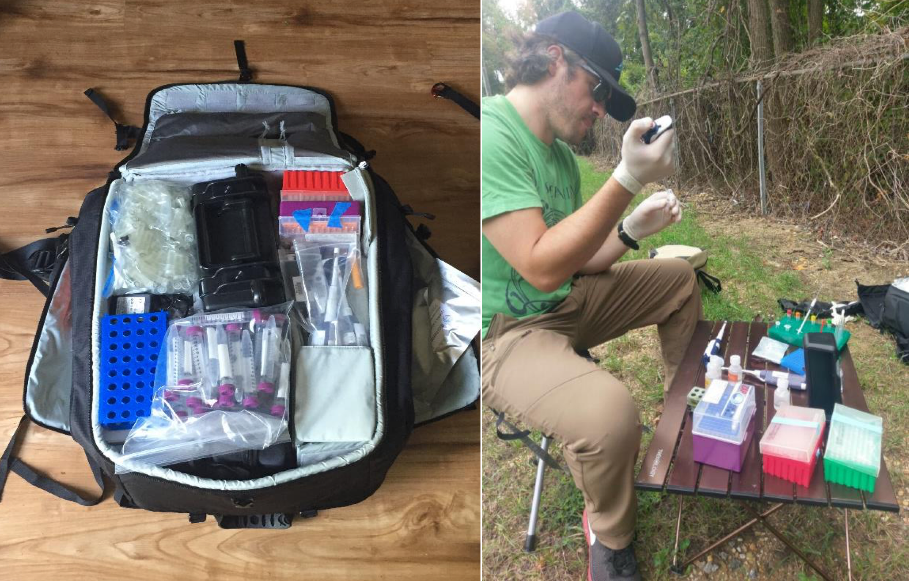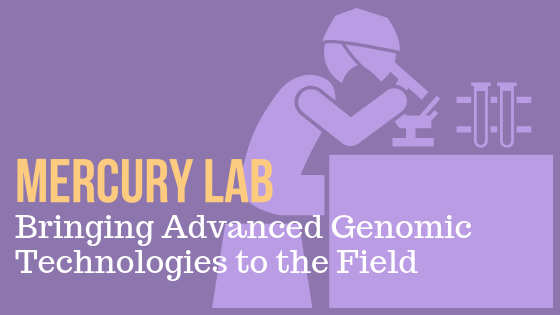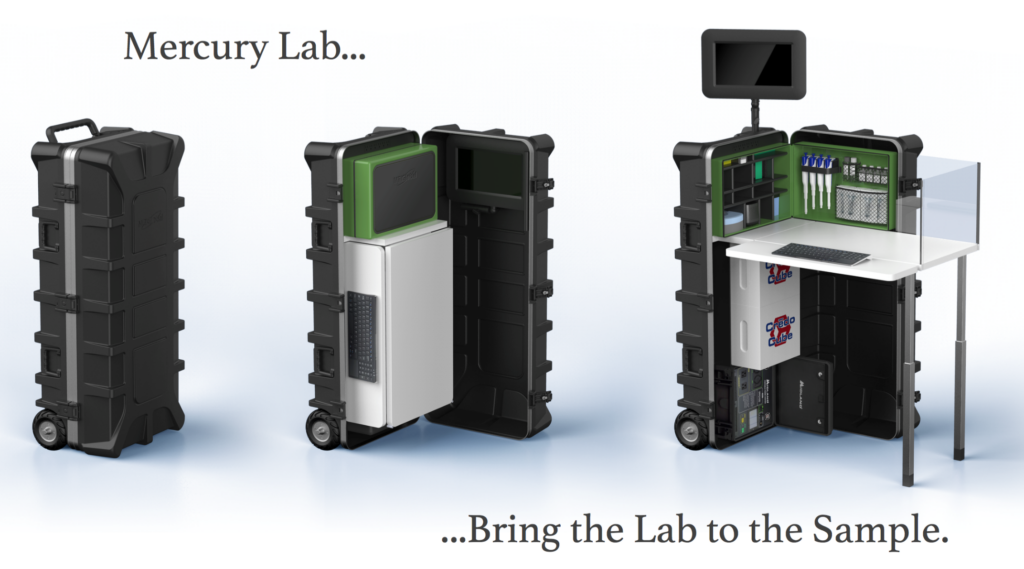The ability to extract biological information from a given environment has undergone substantial change in just the past 3 years. Some of the latest hardware designed for quantitative PCR, antibody and protein detection, and genomic sequencing can easily fit in your coat pocket. The writing on the wall illustrates a future where advanced molecular diagnostics, biosurveillance, and forensic testing no longer requires transporting a sample back to a central reference laboratory. Samples can be processed on site, at the point-of-need, alleviating processing bottlenecks and dramatically reducing the time to acquire an actionable result.
However, this future has not yet been realized.
written by: Joseph Russell, MRI Global
Despite the footprint of the molecular hardware becoming remarkably small, the operational footprint of the work is not equally small. Ancillary equipment including (but not limited to) a stable power supply, cold-chain storage, reagent/consumables storage and transport, computational capacity, a stable workbench, biohazard waste disposal strategies, biosafety equipment, and other logistics – all necessary for the effective use of the full complement of modern, hand-held genomics hardware – are capable of growing the operational footprint of these devices to sizes that are not reasonable to deploy at the point-of-need.
MRIGlobal has developed a product to address this problem. This product is a purpose-built platform that provides all the necessary operational equipment in a human-centered laboratory-workbench design such that rapid, reproducible deployment of advanced genomic technologies to field-forward locations is no longer strategically unfeasible.
From 2014 to 2016, MRIGlobal was staffing a series of mobile BSL-3+ molecular diagnostic laboratories in Guinea and Sierra Leone during the West African Ebola Virus epidemic. MRIGlobal personnel ultimately processed over 19,000 samples, including nearly 100 positives, during their outbreak surveillance and diagnostics mission. While these teams worked tirelessly on rotating 12 hour shifts, it became clear that not all suspected EBOV samples were making their way to the laboratory. While the labs were ‘mobile’ in the sense that they could be put in the back of a transport plane and made operational anywhere in the world within 72 hours, once they were in country, they were a fixed-point lab. If it is rainy season in Sierra Leone, it is not likely that a suspected EBOV sample in Kambia is going to make it to a mobile BSL-3+ facility in Moyamba, nearly 200 km away.
Around this same time, several companies were emerging with the first hand-held molecular biology hardware that was 1) rugged enough, 2) simple enough, and 3) ‘affordable’ enough, such that a truly mobile, fully-outfitted molecular biosurveillance laboratory could be envisioned for routine deployment. A team of scientists within MRIGlobal’s Global Health Surveillance and Diagnostics Division started to whiteboard out what this may look like. Our team wanted to link quantitative real-time PCR with genomic sequencing, so that known and unknown targets could be interrogated in the field, outside of a brick-and-mortar laboratory. Biomeme Inc.’s two-3™ qPCR machine and the MinION from Oxford Nanopore Technologies Inc. provided a starting point.
The goal was simple – a ‘lab in a backpack’. The two-3™ is the size of a coffee mug and the MinION is the size of a candy bar. Surely a backpack was all we would need for those devices and their ancillary consumables.
To test the concept, we teamed up with a pair of entomologists (Drs. Nathan Burkett-Cadena and Erik Blosser) from the Florida Medical Entomology Laboratory. Nathan and Erik were conducting studies on Culex cedecei mosquitoes, a vector for Everglades Virus (EVEV), and offered to have us tag along on one of their sampling trips. Our goal was to use our ‘lab in a backpack’ to conduct arbovirus surveillance for EVEV and determine if what we were envisioning would be truly effective in the field. We purchased an expeditionary photography backpack and packed it with everything we thought would be necessary.

Fieldwork has a tendency to illuminate that which you did not consider. Our Everglades trip was no exception. While we convinced ourselves that the hardware was viable (Russell et al. 2018), we found that a ‘lab-in-a-backpack’ was ill-equipped for all but the leanest of biosurveillance missions. To not only carry, but enable, the full complement of available hand-held genomics technology, we needed a more robust platform. Deep sequencing on the MinION exhausts a laptop battery fairly quickly. We needed more power. The library prep reagents and extracted nucleic acids needed better cold-chain if we were going to be in the field more than a few hours. We needed a stable workbench, preferably with some shelter from the wind, rather than a rickety camping table (or a flat rock). We needed enough working area to set up multiple stages of our workflow and easy access to all of our pipettes and consumables, so we were not going back and forth into the backpack every other minute. We needed better computational capacity to run our preferred bioinformatics software. In short – we needed a laboratory.
Upon returning, our GHS&D biologists sat down with MRIGlobal engineers and began creating something in between a ‘lab-in-a-backpack’ and the mobile BSL-3+ laboratories we were staffing in Sierra Leone – something that took advantage of the small form-factor of modern genomics hardware, but did not compromise on logistics. We wanted a single, lockable, grab-and-go case that could be wheeled through an airport and checked as luggage, thrown in the back of a pickup truck, or even strapped to the back of a motorbike. We wanted something that could be set up on site in a few minutes or less, and be packed up just as quickly. We wanted a way to bring the lab to the sample.
After several prototypes, equally illuminating field excursions, and the input of specialist mechanical, electrical, and industrial design engineers, our team at MRIGlobal has developed the first truly mobile, single-person portable molecular biosurveillance laboratory – Mercury Lab.
Mercury Lab currently has the following features, and more…
- An integrated lithium-ion battery array (Midland PPG100) with 950Wh of power – enough for 18 hours of continuous sequencing.
- Up to 72 hours of 4°C and -20°C cold storage for samples and reagents
- A removable shelving unit that contains a pipette rack with space for 4 pipettes and adjustable cubbies for pipette tip boxes, gloves, spare tubes, tube racks, ambient-temperature reagents, mini-centrifuge, and preferred hand-held molecular biology and/or chemical detection devices. The shelving unit detaches from the larger case into a zipper-secured backpack for deploying your hand-held diagnostic/detection devices even further afield.
- 32GB RAM / 2TB SSD, Bluetooth-enabled and LTE-connected computational workstation (Intel NUC Skull Canyon – NUC6i7kyk) with integrated screen and Bluetooth keyboard/mouse/trackpad. The NUC can be pre-configured with any preferred Linux or Windows operating system and suite of bioinformatics or other analytical software.
- A sturdy, yet collapsible, sterilizable, laboratory workbench with integrated windshield and foldable keyboard tray, providing nearly 6 square feet of workspace.
- Integrated solutions for biosafety and biohazard waste disposal.
What Mercury Lab does not yet have is your input! Our team has years of cumulative field-forward science experience. But it would take many lifetimes to anecdotally discover every way we could improve this product. So, we’d like to ask you – the scientific hive mind. How would you use Mercury Lab? What is it missing? What haven’t we thought of?
Are you a forensics professional with on-site crime scene or disaster victim sample processing needs in rugged or austere environments? Perhaps you are a food producer or distributor responsible for keeping a far-flung network of grocery customers from getting sick? Or maybe you are a physician deployed to disadvantaged areas of the world where cutting-edge diagnostics are all too often out of reach for your patients?
Please fill out the survey linked below to help us understand how we can improve Mercury Lab, and what features may be important to add. We believe this product will lower the barrier-of-entry to a new horizon in biosurveillance, diagnostics, and forensics, at the point-of-need. The future awaits – help us get there today!



